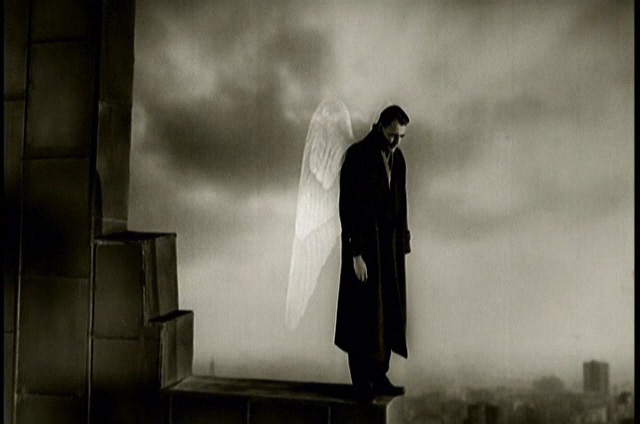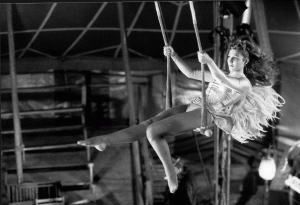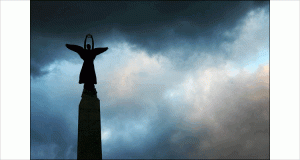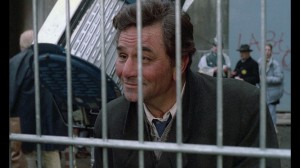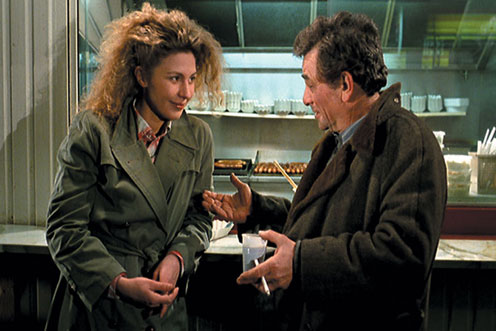From the Chicago Reader (July 15, 1988). Having seen the gorgeous new restoration of this film a little over three decades later, it looks even better now, although my demurrals remain the same. — J.R.
WINGS OF DESIRE
*** (A must-see)
Directed by Wim Wenders
Written by Wenders and Peter Handke
With Bruno Ganz, Solveig Dommartin, Otto Sander, Curt Bois, and Peter Falk.
They all have weary mouths,
bright souls without a seam,
And a yearning (as for sin)
often haunts their dream.
— Rainer Maria Rilke, “The Angels”
Damiel (Bruno Ganz) and Cassiel (Otto Sander) are angels who hover over, swoop across, and cruise through contemporary Berlin in Wim Wenders’s new feature, eavesdropping on the thoughts of the city’s inhabitants like readers browsing through the books in a library. They are not angels in the conventional sense of blessed or fallen souls; rather they are more or less the angels of Rilke’s poetry — the imaginary beings that dominate his first two Duino Elegies and that, according to Rilke, have more to do with “the angelic figures of Islam” than they do with Christianity.
All of which may make Wings of Desire seem esoteric and forbidding to moviegoers who, like me, have only a glancing acquaintance with Rilke, speak no German, and have never before heard of “the angelic figures of Islam.” But in fact, as long as Damiel and Cassiel remain Rilkean angels, Wenders uses them to create a seductive poetry of his own that may be more accessible to American audiences than anything he has done since The American Friend (1977); at least the film’s unforeseen commercial success in New York and Los Angeles seems to suggest as much. Ironically, it is only after one of these angels, Damiel, falls in love with a mortal and forsakes his angelic status to meet her as a human that the film gets into trouble.
Before it gets involved in such issues, Wings of Desire (whose German title, Der Himmel uber Berlin, means the sky or heaven over Berlin) represents a watershed in Wenders’s career. Not only is it a homecoming film, a return to Germany after a decade of working abroad (mainly in the U.S., but with side trips to Portugal and Japan); it also provides a climax to Wenders’s preoccupations with broken narratives and fractured communications, themes that have appeared in his work from Alice in the Cities (1973) to Kings of the Road (1976) to The State of Things (1982) to Paris, Texas (1984). Here the central poetic premise can be located in a single line of dialogue, “Germany has crumbled into as many states as there are individuals, and all of them are mobile.” The very mobile Damiel and Cassiel exist principally, one might say, to implement, articulate, and demonstrate this premise, rather than to illustrate any particular reading of Rilke. Like roving eyes, they scour the city and survey the scattered crumbs; like antennae, they pick up fragments of the various signals in the air (a metaphor that is literalized at one point when the camera drifts past a radio tower and we hear a shifting, kaleidoscopic melange of stations).
The movie’s poetic agenda, in other words, is not so much to show us angels as to show us what they see and hear as they drift through the city. The angels see everything in black and white, and that is how we see the Berlin they pass through (beautifully caught in the crisp images of 79-year-old Henri Alekan, one of the greatest living cinematographers, whose previous credits include Jean Cocteau’s Beauty and the Beast, William Wyler’s Roman Holiday, Wenders’s The State of Things, and Raul Ruiz’s La toit de la baleine; as a tribute to this giant, Wenders names the French circus in the film after him). Children and a few innocent-minded adults are aware of the angels’ presence and smile back at them, and a few individuals seem to intuit certain aspects of their subtle influence, but most Berliners are too deeply sunk in their thoughts and activities to have any awareness of these benign figures in their midst.
What we and the angels hear as they pass from apartments to streets and from motorway to airplane (their travels are captured in graceful and continuous camera movements), and as they mill around three of their favorite spots — the National Library, a World War II bunker that is serving as a film location, and a small French circus that has pitched its tent on a vacant lot (and is preparing to close for lack of funds) — are the internal monologues of the people they pass. The fact that these inner voices are experienced as ongoing texts, as continuous as the camera movements, becomes especially clear in the National Library, where the browsing of the angels matches the action of the humans they tune in to as they glide past.
Most of Wings of Desire follows Damiel and Cassiel on their separate and occasionally common trajectories across Berlin, and the film’s bold refusal to follow any fixed narrative itinerary in what they see and hear yields one of the loveliest sustained passages Wenders has ever given us. One is reminded of some of the great city films of the past, particularly those of the 20s — documentaries such as Walter Ruttmann’s Berlin, Symphony of a City and fiction films such as F.W Murnau’s Sunrise — which present cities as complex networks of interlocking and crisscrossing destinies. Even closer comparisons can be made with the first half of Jacques Tati’s Playtime and portions of Robert Altman’s Nashville and Rainer Werner Fassbinder’s Berlin Alexanderplatz, which concentrate more on the isolation and disconnectedness of individuals within these urban networks.
The main humans who are followed by the angels in this section are Homer (Curt Bois), an elderly and retired professor who visits the National Library and strolls across the depleted Potsdamer Platz, recalling the shops and cafes that used to be there; Marion (Solveig Dommartin), the mortal with whom Damiel falls in love, a French trapeze artist in the Circus Alekan who after rehearsing her act retreats to her trailer to listen to music and reflect on her loneliness; and Peter Falk, playing himself (and reportedly collaborating on his own effective dialogue), an American movie star playing a detective in a film set in the Berlin of 1945, on a location consisting of the remains of a multitiered World War II bunker. (The internal monologues of these three characters are all conducted in their native tongues — German, French, and English — which makes a certain amount of the film trilingual.)
During this long section, there are a few privileged moments when the screen briefly turns from black and white to color; all of them appear to be subjective moments when Damiel or Cassiel has a sudden insight into what it means to be human. The first two of these moments occur in Marion’s trailer, when Damiel is beginning to fall in love with her; the next two are flashes of color newsreel footage of war ruins, when Homer crosses Potsdamer Platz, and when Falk, sketching various extras to pass time on the set, thinks about the end of the war. Another instant of color occurs just after a young man commits suicide by jumping from a rooftop, Cassiel having been unable to stop him; and still another, more mysterious instance comes after Damiel takes leave of Marion, who is dancing alone to an Australian punk band (Crime and the City) in a rock club, and looks in at a laundromat. What is most striking about all of these quick shifts is their visceral impact in relation to the black-and-white footage. Most films use color so routinely and automatically that it seldom functions as a dynamic principle; here Wenders uses it so that it packs a wallop, allowing the angels and the audience a sudden glimpse into life’s other side.
After Damiel has a long conversation with Cassiel, and a subsequent encounter with Falk in which the latter senses his presence (“I can’t see you, but I know you’re here . . . I wish you could talk to me”), he decides to become human so that he can meet Marion. Awaking to his full-color human state beside the Berlin Wall, he is delighted to be able to taste the blood on his fingers and to identify the colors of pipes on the ground and on the mural that decorates the Wall (freshly repainted for the purpose of the film). The remainder of the movie, apart from a few shots showing Cassiel’s viewpoint, takes place in full color.
Happily entering the material world, Damiel sells his angelic breastplate at a junk shop in order to buy a loud, checked jacket; reencountering Falk, he discovers that the movie star was once an angel, too. After learning that the circus has left town but that Marion has stayed behind, he searches the city for her, and eventually finds her at the rock club, where another Australian punk group (Nick Cave and the Bad Seeds) is playing.
Finally coming face to face with one another in an adjacent bar, Damiel and Marion declare their mutual love and kiss, but not before Marion delivers a lengthy monologue, in German, insisting that they have to be very serious about their love, and must reinvent male-female relationships on behalf of all couples everywhere. Later, Damiel watches in admiration as Marion practices her aerial stunts above him on a rope that he’s holding (presumably she’s a near-angel by virtue of her profession), and subsequently he writes in his diary that he now knows what no angel knows. Cassiel, more worldweary, decides to go on with his angelic knowledge and become Berlin’s collective memory and conscience. The film concludes hopefully with the title, “To be continued . . .”–presaging not so much a sequel as an offscreen fusion of Oz and Kansas, or at least some Wenders version of never-never land.
Perhaps the most attractive of all the New German Cinema romantics (as well as the most able inheritor of Antonioni’s existentialist bent for framing open spaces and enclosing empty chunks of time so that they vibrate mysteriously), Wenders is generally as underrated in this country as he is overrated in Europe. Potentially a major director, he is an artist whose talents are defined in part by his limitations. In the past, he has often been perceived as being at his most confident when he remains in the register of the nostalgic buddy film, as in Kings of the Road and The American Friend. For me, however, his strongest works are all flawed but pungent hybrids of European and American elements: Alice in the Cities, with its effective broodings over American and German landscapes and their ambiguous photographic representations; Hammett (1982), which belatedly fulfilled the French New Wave’s dream of mating a European sensibility with an American subject and the resources of a Hollywood studio; and The State of Things, which perfected his treatment of narrative breakdown as existential crisis, and drew on his own experience with European and American modes of film production to stage a profound satiric encounter between them. One might also include another sort of hybrid, Wrong Move (1975), the better of Wenders’s two previous collaborations with Austrian writer Peter Handke — a modern adaptation of Goethe’s Wilhelm Meister that brought a bunch of German eccentrics together and set them off on scenic walking tours, uniting the picaresque novel and the road movie in a haunting fashion. (All these titles, as well as Wenders’s other features, are now available on videotape, and strongly recommended to viewers who may have missed them.)
The two most conspicuous thematic failings of Wenders’s work have been his refusal to grapple directly with political issues and an inability to persuasively handle male-female relationships involving full-grown women who think, talk, and exist independently of their men and without benefit of pedestals. Although East Berlin, the Berlin Wall, migrant workers, and the Nazi era all figure in the physical landscapes of Wings of Desire, efforts to deal with any of them politically are excluded even from the internal monologues, and the angels themselves are clearly “above” such matters. The absence of female angels and their own view of Berlin is equally significant. The deepest unspoken relationships in Wenders’s films usually exist either between men or between men and children; the rapport between Damiel and Cassiel in Wings of Desire is emblematic of this pattern. The climactic confrontation of Nastassia Kinski and Harry Dean Stanton separated by a two-way mirror in Paris, Texas is indicative of both Wenders’s desire to break this pattern and his inability (so far) to do so.
Marion and Damiel may not be physically separated by a two-way mirror, but their abstract rhetoric about love in general (admittedly hampered by the translation of very literary German into English subtitles) performs the same function, and there is not even the link of a shared past and child (as in Paris, Texas) to bind the two lovers together. Ending Wings of Desire with “To be continued . . .” is a little bit like marking this newly formed love match as a subject for future research. In terms of what we see and hear, the relationship is purely hypothetical and has nothing lived or worked-through about it. The overall switch from black and white to color is finally disheartening not because the film’s documentary strengths have given way to fiction, but because the fiction itself is so meager and shopworn — another Hollywood romance, like One From the Heart.
On the other hand, as long as Wings of Desire stays aloft on its exhilarating wings of pure possibility, the past of Berlin as well as its present has an undeniable vibrancy and immediacy. Even when the film touches ground, the charismatic earthiness of Falk, the haunted memories of Homer, and the solitude of Marion all give the city some emotional foundation. It’s only when Damiel becomes a mensch that the film’s fairy-tale precepts — which at their best evoke Cocteau’s Orphee — become reductive and jejune.

